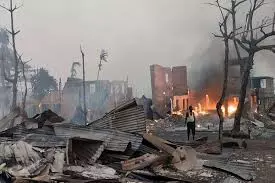AA Edit | Trouble for Myanmar rises on many fronts
Adding to the natural disaster last Friday was a deliberate man-made tragedy in the junta carrying out three bombing raids in the quake-hit areas of Kayin state and southern Shan on the Thai border within hours of the people there having been jolted by nature

The people of Myanmar must consider themselves doubly cursed. A natural calamity of a horrendous order, measuring about 7.7 on the MMS scale of earthquakes as tectonic plates moved to cause the biggest temblor in decades, was not the only thing that caused them unimaginable distress.
A substantial percentage of Myanmar’s 54 million population has already been displaced in a military junta rule that has terrorised civilians in its battle against a rebel movement. Adding to the natural disaster last Friday was a deliberate man-made tragedy in the junta carrying out three bombing raids in the quake-hit areas of Kayin state and southern Shan on the Thai border within hours of the people there having been jolted by nature.
Such is the lot of many of the Myanmarese that a unilateral ceasefire call should go out from the shadow National Unity government which coordinates the struggle against the military. An incredulous resident said he could not believe “they did airstrikes at the same time as the earthquake”. It is even more of a crying shame that affected people should say the bombing did little damage as the area had already been ravaged in Myanmar’s raging civil war and most rebels were in the jungles where shaking trees were the bigger threat.
The quake and its aftershocks have been so powerful and caused such damage to urban areas around Mandalay, with buildings, bridges and roads torn apart in the country’s second largest city, that the usually reticent top brass of the junta had to make a public appeal on television to the international community for aid.
Prime Minister Narendra Modi not only spoke to Gen. Min Aung Hlaing, who had just made an unprecedented call for global help, but also saw to it that Indians were the first international responders after moving a field hospital with 118 medical personnel and a team of search specialists, besides a huge supply of aid material in four ships and two aircraft, quickly to Yangon and onwards to Mandalay.
Myanmar may be following the international practice in disasters of first counting the number of dead bodies to arrive at the human toll, but it is a chilling comment on the country that it could scale down the deaths manifold and the official figure jumped from 160 to 1,644 in a day whereas an estimate of the actual toll could be around 10,000, according to the United States Geological Service.
Given the scenario of a three-year war all over non-urban areas for control of territory between the junta’s forces and the rebels, coordinating the logistics for the aid that will be coming from many countries, including India, China, Russia and the US, will be a challenging task; more so the reconstruction of living spaces torn apart by the quakes caused by the Sagaing Fault, a major north-south fault that separates the India plate and the Sunda plate.
The question of whether the junta will survive such a national disaster is all but irrelevant. Not even a people rather given to superstitious interpretations of signs and calamities can hazard much of a guess as to what the future may hold for one of the poorest nations on earth that has been destined to be ruled by martial law.
Neighbouring Thailand was relatively fortunate that the quake’s effect felled only a 30-storey skyscraper under construction and the loss of life was counted at 17 though the fate of around 79 people buried in the building debris is as yet unknown.
